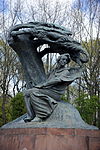Belweder
1822 establishments in PolandHouses completed in 1822Neoclassical architecture in WarsawOfficial residences in PolandPalaces in Warsaw ... and 3 more
Presidential residencesRoyal residences in PolandState guesthouses

Belweder (Polish pronunciation: [bɛlˈvɛdɛr]; from the Italian belvedere, "beautiful view") is a neoclassical palace in Warsaw, Poland. Erected in 1660 and remodelled in the early 1800s, it is one of several official residences used by Polish presidents as well as a state guest house for visiting heads of state. The complex is situated south of Warsaw's city center, in the vicinity of the historic Royal Baths Park (Łazienki).
Excerpt from the Wikipedia article Belweder (License: CC BY-SA 3.0, Authors, Images).Belweder
Belwederska, Warsaw Śródmieście (Warsaw)
Geographical coordinates (GPS) Address External links Nearby Places Show on map
Geographical coordinates (GPS)
| Latitude | Longitude |
|---|---|
| N 52.213055555556 ° | E 21.027777777778 ° |
Address
Belweder
Belwederska 56
00-594 Warsaw, Śródmieście (Warsaw)
Masovian Voivodeship, Poland
Open on Google Maps










